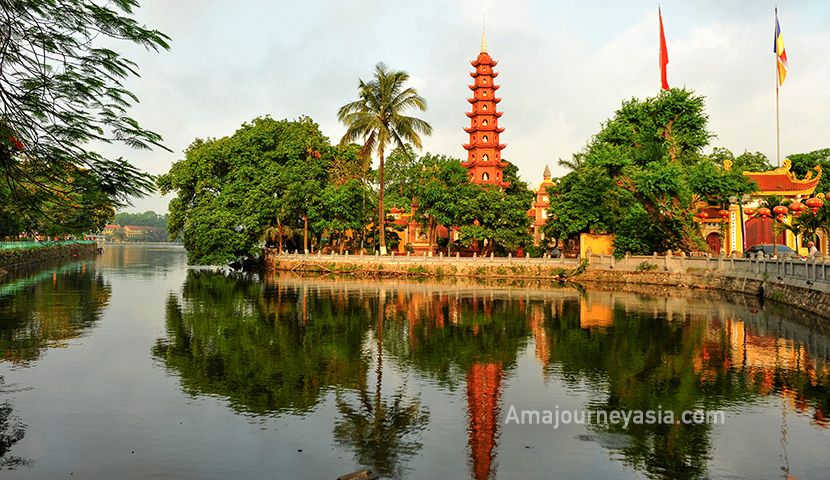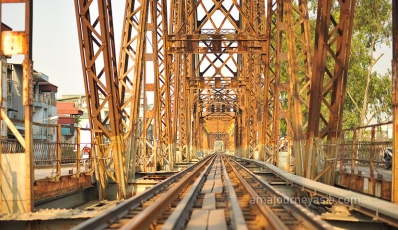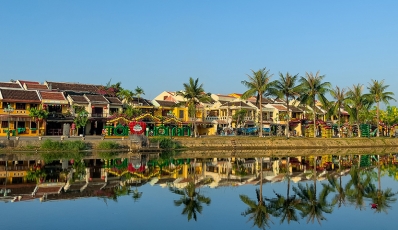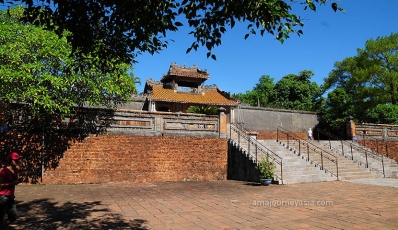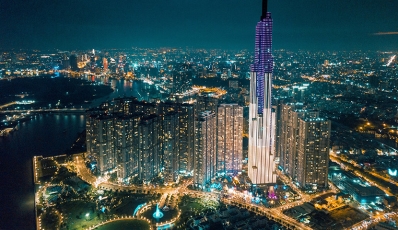Tran Quoc Pagoda, with a history spanning over 1500 years, occupies a truly significant place in the growth and progress of not only Vietnam as a whole but also the vibrant city of Hanoi. This paramount significance is the primary magnet that draws countless visitors from across the globe to this sacred pagoda each year.
According to the Wanderlust website, Tran Quoc Pagoda proudly secures a spot in the esteemed top three positions among the ten most breathtaking pagodas in the world. This recognition further accentuates the pagoda's remarkable beauty and allure.
*****
Table of content
History of Tran Quoc Pagoda
Architecture and Structure of Tran Quoc Pagoda
Tien Duong - Front House
Nha To - Ancestor House
Nha Bia - The Stele house
What to see in Tran Quoc Pagoda ?
Notices when visiting Tran Quoc Pagoda
*****
Location and How to get to Tran Quoc Pagoda
Located in Thanh Nien street. 1 site is Truc Bach Lake and the other is West Lake. Tran Quoc Pagoda is conveniently located a mere 5 kilometers away from the bustling city center, allowing visitors to access it through various modes of transportation.
By bus: An effortless option is to take bus No. 50, which conveniently drops you right in front of the pagoda. Alternatively, you can board buses No. 31, 41, 55A, 55B, or 58, which will take you to An Duong bus stop. From there, a pleasant 5-minute walk will lead you to the pagoda.

Map to Tran Quoc pagoda
New tourist bus: Hop on - Hop off bus will take you around Hanoi city and Tran Quoc Pagoda is one of the stops on the route.
By taxi: Opting for a taxi ride is recommended, and you can easily book one through the Grab application on your mobile phone for a hassle-free journey to the pagoda.
By motorbike or bike : For those seeking a more adventurous mode of transport, renting a motorbike or bike provides the flexibility to explore the scenic West Lake area. The pagoda can be reached within approximately 12 minutes of riding from the city center.
Whichever transportation option you choose, reaching Tran Quoc Pagoda is a convenient and enjoyable experience.
By cyclo: It is a great way to relax while enjoying the landscape from this special vehicle in Hanoi.
History of Tran Quoc Pagoda
Dating back 1500 years ago, Tran Quoc Pagoda was initially constructed during the reign of the Ly Nam De dynasty (541 – 547) on the banks of the majestic Red River. It was bestowed with the name Khai Quoc Pagoda, which translates to "Opening country pagoda." Centuries later, during the Le Thai Tong dynasty, the pagoda underwent a renaming and came to be known as An Quoc Pagoda, symbolizing the "Pacification of The Realm." Throughout its rich history, the pagoda has witnessed the passage of time and stood as a testament to the cultural and historical significance of Vietnam.

Tran Quoc Pagoda in the past
Due to its original location alongside the riverbank, Tran Quoc Pagoda faced the inevitable challenges posed by the natural phenomenon of landslide and accretion. These environmental factors had a negative impact on the pagoda, prompting a relocation to a mound known as Kim Nguu (golden buffalo) in West Lake in 1615.
At that time, there was no direct road connecting to the pagoda. To address this, Trinh Lord commissioned the construction of a road that traversed the mound, which eventually came to be known as Co Ngu Street. Presently, the road bears the name Thanh Nien Street.
During the reign of the Le Huy Tong dynasty (1681 – 1705), the pagoda underwent yet another renaming, this time being called Tran Bac, which signifies "Guardian of the North Pagoda."
Nevertheless, the name Tran Quoc Pagoda eventually emerged as the primary designation and has endured to the present day, encapsulating the historical significance and reverence associated with this revered place of worship.
Architecture and Structure of Tran Quoc Pagoda
Tran Quoc Pagoda showcases the distinctive and emblematic features of Buddhist architecture, prominently displayed through its three main structures. These include Tien Duong (the front house), Nha Thieu Huong (the incense burning house), and Thuong Dien (the upper house), interconnected in a configuration resembling the Chinese character "Cong" (工).

Statues in Upper House of Tran Quoc Pagoda
Located behind the upper house is Gac Chuong, a three-part structure positioned along the path leading to the main hall. This architectural element adds an extra layer of grandeur to the pagoda, enhancing its overall aesthetic appeal and inviting visitors to explore its sacred spaces.
The intricate design and arrangement of these buildings at Tran Quoc Pagoda reflect the careful attention to detail and symbolism within Buddhist architectural traditions. They contribute to the spiritual ambiance and visual splendor of the pagoda, captivating all who have the privilege of experiencing its serene atmosphere.

The gate of Tran Quoc Pagoda
Upon passing through the gate, you will embark on a journey along a pathway paved that leads you to the captivating interior space of Tran Quoc Pagoda.
This charming pathway guides visitors as they venture deeper into the pagoda, creating a visually appealing and welcoming atmosphere.
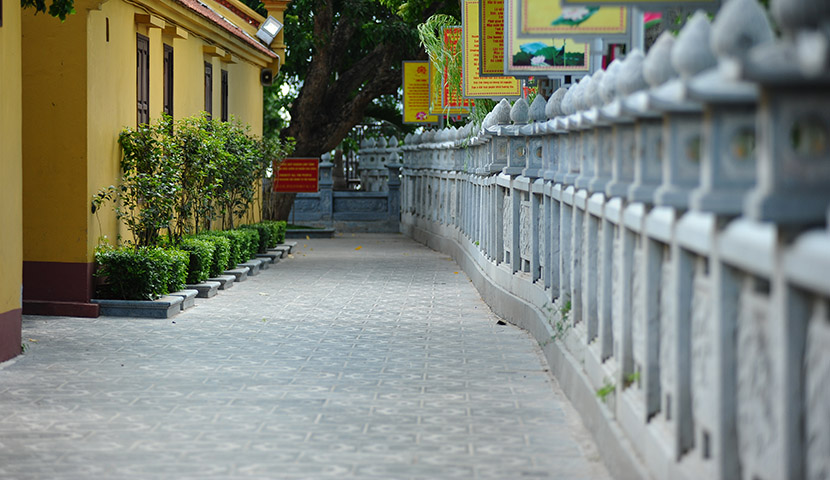
Pathway leading from the gate to interior space of Tran Quoc pagoda
The distinctiveness of the brick pathway adds an element of character to the overall experience, further enhancing the allure of the pagoda's interior.
At Tran Quoc Pagoda, you will encounter distinct parts of pagoda that contribute to its architectural charm:
Tien Duong
Known as the Front House, is positioned in front of the bell tower and faces west. It serves as a prominent structure that greets visitors upon their arrival.
In the yard of Tien Duong, you will find an incense burner, where both Buddhists and tourists can partake in the act of thurification, offering a sense of tranquility and spiritual connection.
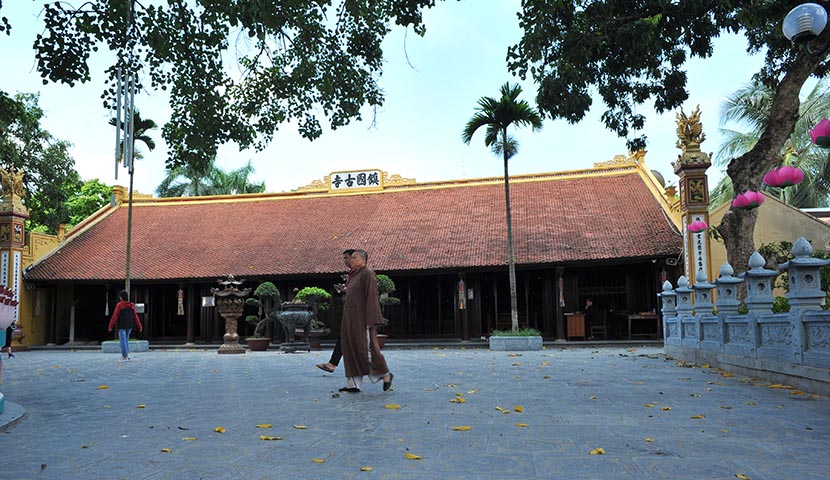
Incense burner at Front House of Tran Quoc Pagoda
Nha To
The Ancestor House can be found on the right side of Tien Duong. Within its sacred walls, it pays homage to the previous generation of revered monks, creating a space for remembrance and reverence.
Nha Bia - The stele House
On the left side of Tien Duong, you will discover Nha Bia, also known as the Stele House. This house is home to 14 significant steles, engraved between 1813 and 1815.
These steles showcase the meticulous restoration and renovation process that the pagoda underwent after enduring a long period of neglect and ruin. They serve as valuable historical artifacts, shedding light on the pagoda's rich heritage.
Together, these distinct structures within Tran Quoc Pagoda offer visitors a glimpse into its historical significance, spiritual practices, and the enduring efforts to preserve its sacred essence.
That is the reason why Tran Quoc Pagoda was bestowed with the esteemed title of a national monument by the Ministry of Culture and Information in 1962.
What to see in Tran Quoc Pagoda ?
Within the serene garden of Tran Quoc Pagoda, visitors are blessed with the opportunity to behold the sacred Bodhi Tree, adorned with its distinctive heart-shaped leaves. This revered tree holds a significant history as it was graciously donated to the pagoda in 1959 by the esteemed Indian President, Rajendra Prasad.

Budda Tree in the Tran Quoc Pagoda
Many hold a profound belief that this very tree is a branch of the sacred Bodhi Tree under which the Buddha attained enlightenment. As a result, tourists and pilgrims from all corners of the globe embark on a spiritual journey to pay homage to this monumental symbol.
It serves as a beacon of veneration, drawing individuals seeking spiritual solace and a deeper connection to the teachings of Buddhism.
Notably, the front house houses worshiping statues that have stood the test of time. Of particular importance are the statues of the Three Sages and the ancestor monks of the pagoda, each possessing its own unique aura and story.
However, the most remarkable and esteemed artifact within the collection is the statue of Buddha entering Nirvana, often referred to as the Reclining Buddha.
One cannot overlook the magnificent presence of "Bao Thap Luc Do Dai Sen" at Tran Quoc Pagoda. This remarkable eleven-story tower stands at a height of 15 meters and was constructed in 1998.
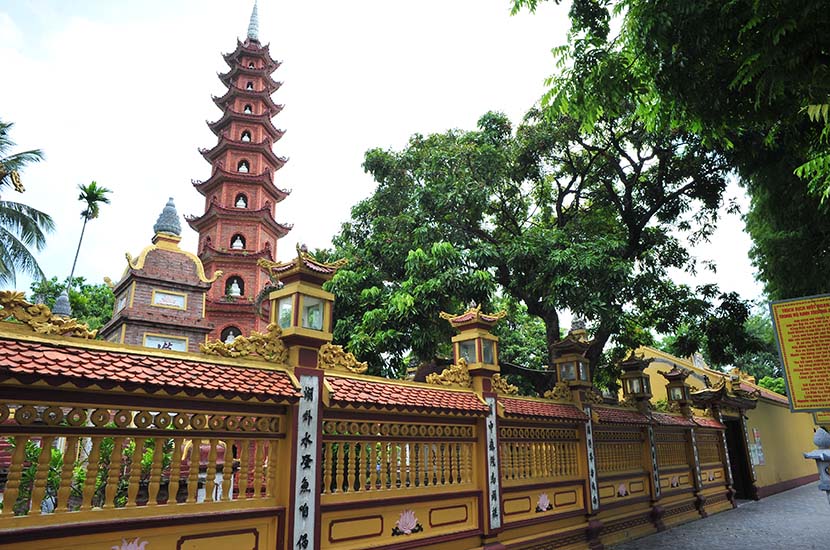
Buddha Tower in Tran Quoc Pagoga
Its architectural splendor is evident through its six arched doorways, each adorned with a statue on every floor. These statues beautifully depict Buddha Amitabha and are crafted from precious stones, adding a touch of opulence to their divine presence.
Notices when visiting Tran Quoc Pagoda
The entrance fee: Free
Opening hours: From 8.00AM to 4.00PM daily.
When visiting Tran Quoc Pagoda, It is important to wear clothing that conforms to the established guidelines, avoiding any attire that reveals excessive skin. Respecting the sanctity of the pagoda through appropriate clothing choices is a fundamental aspect of the visit.
It is customary to remove hats, umbrellas, and shoes before entering the shrines for worship.
For professional photographers: Tran Quoc pagoda is a great place for shooting a masterpiece at sunset, especially sunset on the first day and the full moon day ( the day 15 of the lunar month), when the buddha tower is lit.
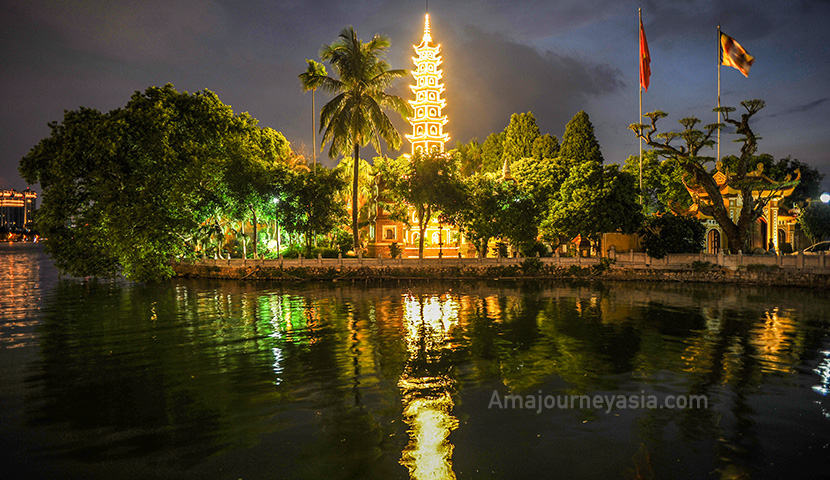
The beauty of Tran Quoc Pagoda when the light is on
Relate article
